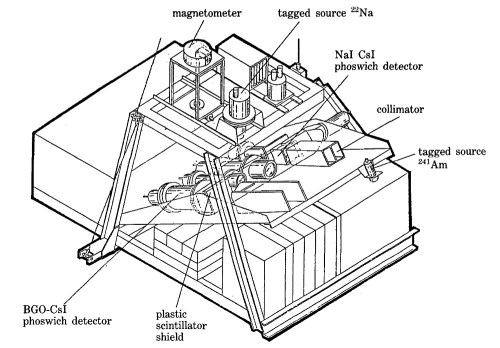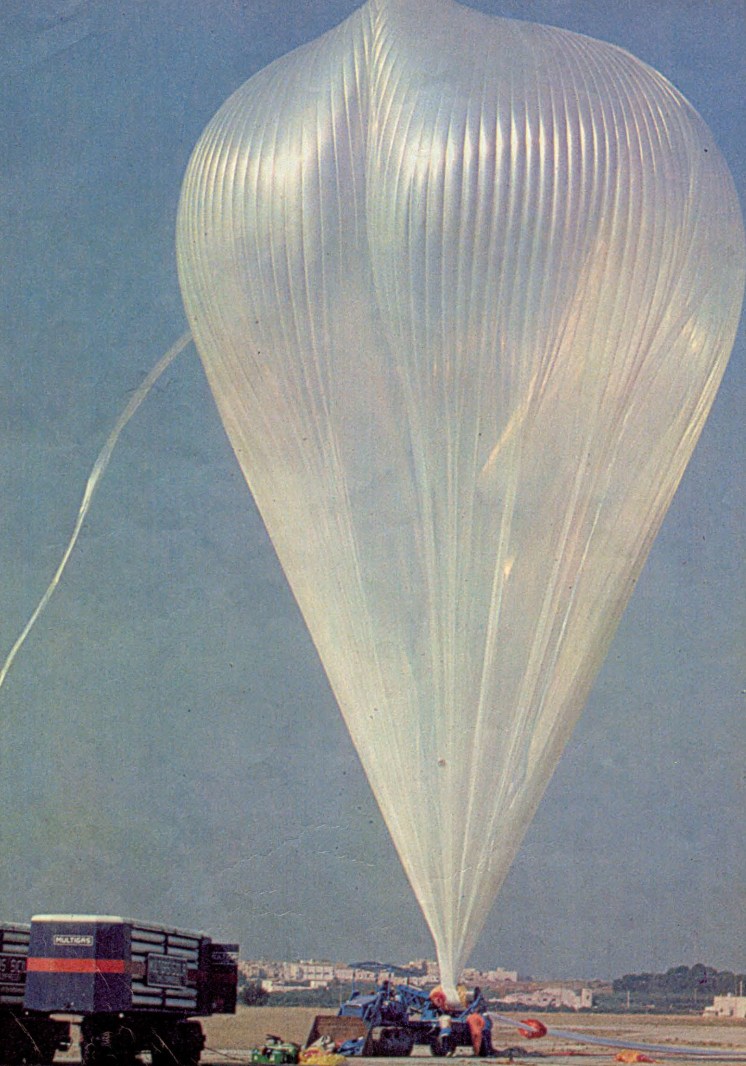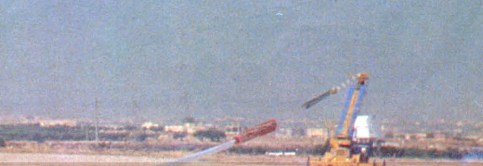Purpose of the flight and payload description
The SUGAR experiment was originally an experiment to verify the performances of Bismuth germanate (BGO) / Caesium iodide (CsI) phoswich detectors, in the domain of gamma-ray astronomy, which was converted into a small-size experiment to detect X-gamma ray emissions from the supernova SN1987A.
It had four main scintillator detectors (one for X-rays and three for low-energy gamma-rays) based on the phoswich technique and a shield of plastic scintillator. Two additional detectors with radioactive sources of very low activity were used to tag calibration photons for the continuous monitoring of gains of the four main detectors.
A general view of the whole payload is shown at left. The gamma-ray detectors are BGO-CsI (T1) phoswich modules. Each is mounted within a pressurized can of aluminum, also including the photomultiplier (PMT), voltage divider, power supply and preamplifier; detectors 2 and 3 are directly coupled to the bi-alkali PMT window, while detector 1 is optically coupled through a quartz window (10 mm). The X-ray detector no. 4 is a classic NaI(T1)/CsI(Na) phoswich combination. It is mounted with external PMT, through a lead glass window, and a potted voltage divider.
The plastic scintillator is a rectangular frame of PLEXIPOP (metacrylate based scintillator) surrounding the main detectors, 30 mm thick and 50 mm high. A thin sheet of the same material (3 mm thick) is also between the front of the three gamma-ray detectors and the respective collimators, while the entrance of detector no. 4 is free. All the ensemble is seen by a single 3 inch diameter PMT.
Each gamma-ray detector is equipped with a four slat lead collimator with a thickness of 8 mm. The resulting field of view is 12 degree FWHM in the azimuth direction and 24 degrees in the zenith one. The collimator of detector no. 4 is made with a thinner lead shield, covered by tin in order to capture Pb fluorescent photons. The same field of view of the other detectors is achieved by halving the length and inserting an additional vertical slat. The zenithal pointing is fixed at 55 degrees from the vertical, in order to track the SN1987A with the azimuth motion only. The signals from each PMT are fed through a voltage-follower preamplifier, amplified, stretched and A/D converted whenever the event is not vetoed by the logic.
Details of the balloon flight
Balloon launched on: 10/10/1987 at 3:28 utc
Launch site: Poços de Caldas Municipal Airport, Minas Gerais, Brazil
Balloon launched by: Instituto Nacional de Pesquisas Espaciais (INPE)
Balloon manufacturer/size/composition: Zero Pressure Balloon 230.000 m3
End of flight (L for landing time, W for last contact, otherwise termination time): 10/10/1987 at ~ 18:30
Balloon flight duration (F: time at float only, otherwise total flight time in d:days / h:hours or m:minutes - ): 18 h
Landing site: In Alpinópolis, Minas Gerais, Brazil
Payload weight: 850 kgs
The only mission of the instrument took place in 1988 over Brazil. During the flight the SN 1987A supernova was in the field of view only for a short time (about 30 minutes) in the beginning of the flight, then the instrument was pointed toward the regions of the radio-galaxy Cen A and of the Galactic Center. Several offset pointings were also performed to measure the background. As a result, the mission demonstrated that the BGO/CsI combination with passive collimation can reasonably compete with experiments which employ a weighty active shield in the bottom and on the sides.
External references
- Instrumentação a bordo de balões amplia conhecimento do universo Revista Espacial Año XVII Nº 68 - Marzo/Abril 1988
- Observações na faixa de raios X e gama da supernova SN 1987A usando detectores "phoswich" BGO-CsI (T1) Thesis by Carlos A. Wuensche de Souza
- Scientific balloons: historical remarks Memorie della Società Astronomica Italiana, v.79, p.783 (2008)
- The SUGAR Experiment, Technical Description and Performances Nuovo Cimento C, Serie 1, vol. 13 C, Mar.-Apr. 1990, p. 497-504
1734If you consider this website interesting or useful, you can help me to keep it up and running with a small donation to cover the operational costs. Just the equivalent of the price of a cup of coffee helps a lot.





